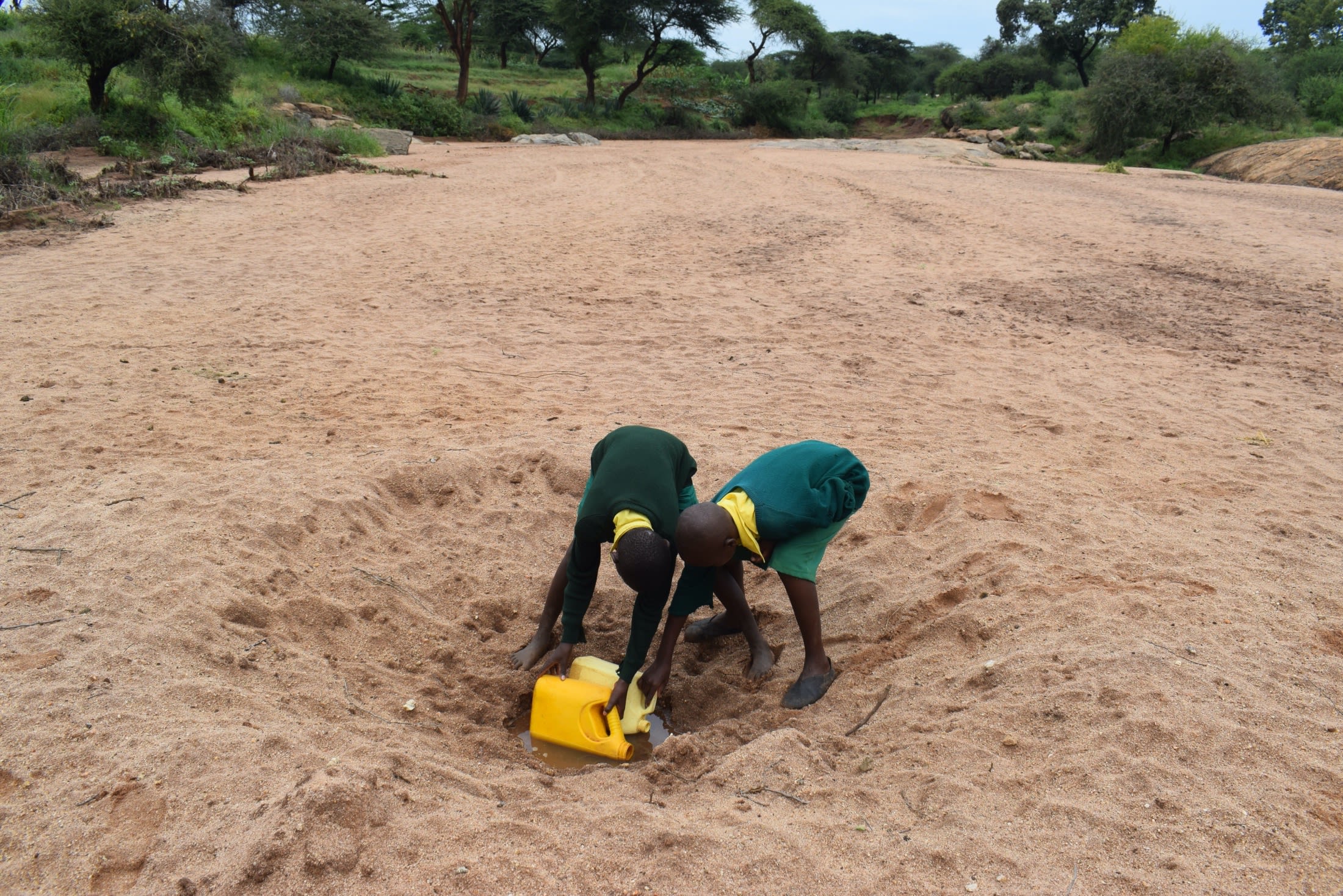The Musosya Primary School consists of 213 students and staff who all feel the devastating effects of their water crisis. Their rain collection tank is too small, so students are forced to haul heavy jerricans full of water from contaminated scoop holes (representative photo below) to school.

"My home is about a kilometer (0.5 miles) from the school, and carrying a 5-liter jerrican with a load of books on my back is very exhausting, and writing anything that is being taught is hard because my muscles get worn out. We suffer from [an] acute water shortage in the school, and getting water to drink is an irritating inconvenience. That is why I have to resort to drinking any available water even [if] it is contaminated," said 14-year-old Simba W., shown below.

"Although it may quench the thirst for a few hours, I often develop stomach aches or diarrhea, like last week when I got sick and had to go home and report it to my parents. Using the latrines in the school is also a hassle because they have an unpleasant smell which sticks on my uniform whenever I use them," Simba continued.
Contaminated water keeps kids out of class and steals their families' meager resources when they have to seek medical care.
Teacher Samuel Maina (seen below) shared, "Our pupils have to arrive as early as 6:00 am to school; thus, they have to fetch water in the evening while at home that they will carry to school in the morning every day. We always have pupils who are late to school every day because most of them reside far away from the school. When there is no water at home, learners may not come to school for fear of being punished."

"They also carry water in open 5-liter jerrycans that collect dust when coming to school and during storage. The water is also drawn from open and contaminated scoop holes, which has caused water-related infections among the pupils. For instance, this term, we had several incidences of stomach aches and diarrhea among the pupils, and we had to send them to the dispensary (clinic)," he continued.
Field Officer Alex Koech said, "The installation of the water point project in the school will ensure a clean water supply within the school premises and prevent infections related to water contamination. The students will no longer walk to school carrying contaminated water from scoop holes, which will eradicate lateness and improve the pupils' attention span during lessons. Hygiene and sanitation will also improve because the proposed project will ensure a continuous water supply even during the dry months."

"The construction of a tank in our school will be a great reprieve because I will be drinking contamination-free water and no longer carry water to school. We will also be cleaning our latrines, and our classes will now be mopped rather than sprinkled with water like we used to do in the past," concluded Simba.
Installing the 104,000-liter rain collection tank will help ensure the children of Musosya Primary School have a chance at a brighter future. Education is the only way to break the cycle of poverty; the first step has to be clean, accessible water. With the new rain tank, students will no longer have to search for water and collect from unsafe sources and will no longer be too exhausted to focus in class. Teachers like Samuel can ease their worry about their students and will get back class time that is now lost to water collection and illness.
Water at schools is unique, which is why we need unique solutions.
The Proposed Solution, Determined Together...
At The Water Project, everyone has a part in conversations and solutions. We operate in transparency, believing it benefits everyone. We expect reliability from one another as well as our water solutions. Everyone involved makes this possible through hard work and dedication.
In a joint discovery process, community members determine their most advantageous water solution alongside our technical experts. Read more specifics about this solution on the What We're Building tab of this project page. Then, community members lend their support by collecting needed construction materials (sometimes for months ahead of time!), providing labor alongside our artisans, sheltering and feeding the builders, and supplying additional resources.
Water Access for Everyone
This water project is one piece in a large puzzle. In Kenya, Sierra Leone, and Uganda, we're working toward complete coverage of reliable, maintained water sources that guarantee public access now and in the future within a 30-minute round trip for each community, household, school, and health center. One day, we hope to report that this has been achieved!
Training on Health, Hygiene & More
With the community's input, we've identified topics where training will increase positive health outcomes at personal, household, and community levels. We'll coordinate with them to find the best training date. Some examples of what we train communities on are:
- Improved hygiene, health, and sanitation habits
- Safe water handling, storage & treatment
- Disease prevention and proper handwashing
- Income-generation
- Community leadership, governance, & election of a water committee
- Operation and maintenance of the water point
Handwashing Stations
Alongside each water source in Southeast Kenya schools, we also provide three new handwashing stations fitted with three taps each, allowing nine students to wash their hands at once. These will allow everyone at the school to wash their hands without running water. Handwashing is so important to help prevent future water-related illnesses in the school community.
The student health club will maintain the stations, fill them with water, and supply them with soap (which we will teach the school community how to make during the training!).

 Rainwater Catchment
Rainwater Catchment
 Rehabilitation Project
Rehabilitation Project


























